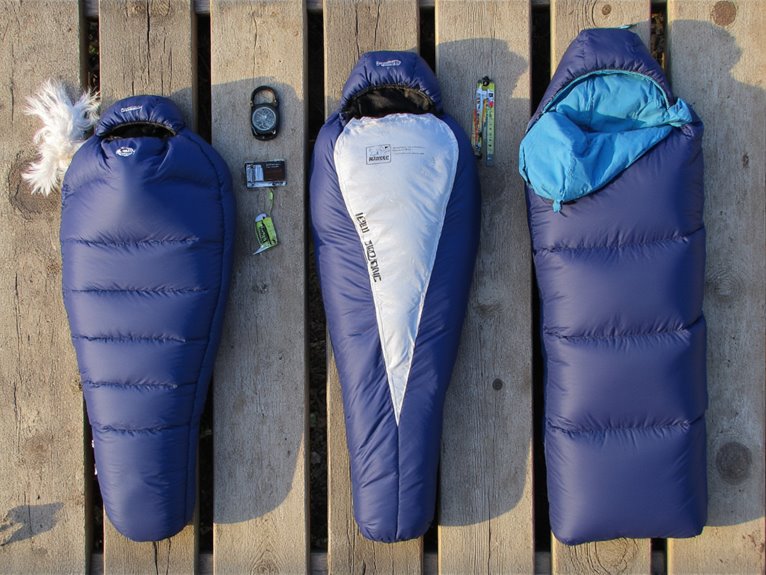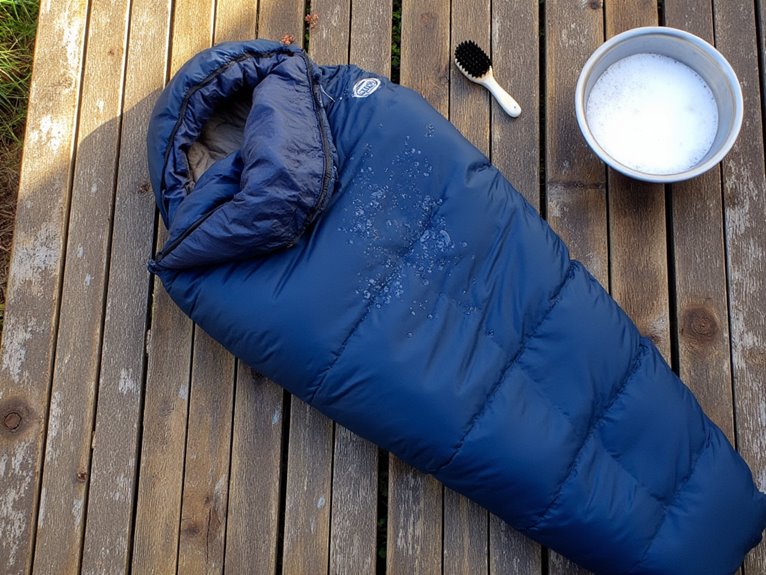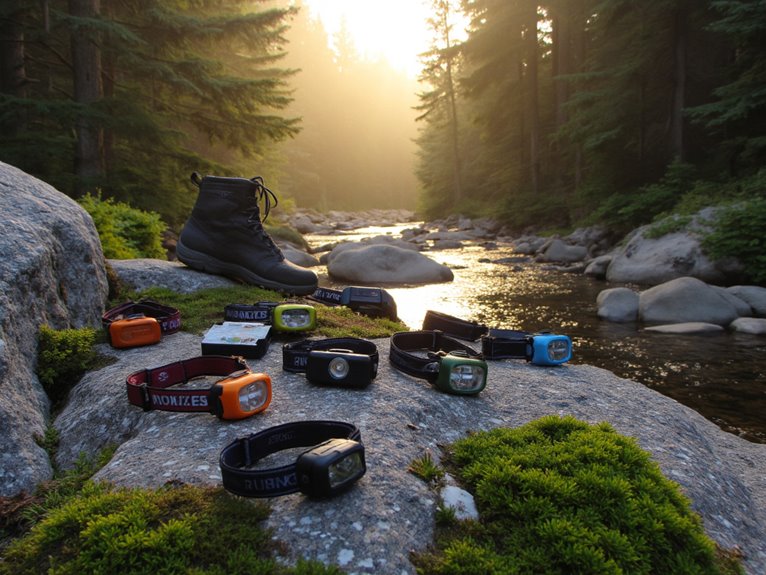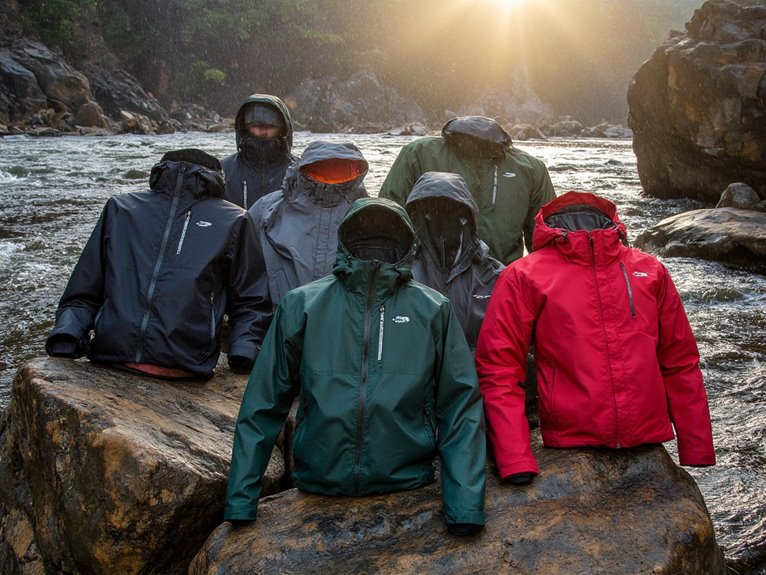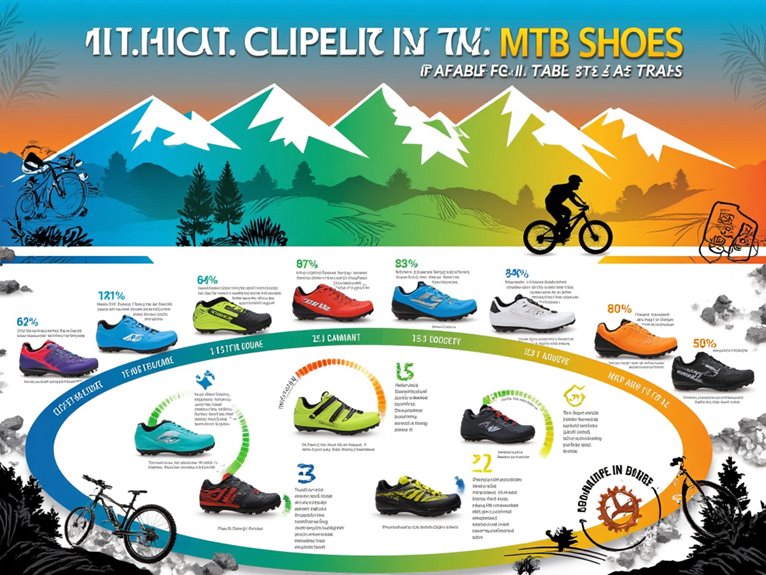How to Choose a Sleeping Bag
You’ll need to match your sleeping bag’s temperature rating to expected conditions, choosing comfort ratings 10-15 degrees warmer than forecasted lows. Select mummy bags for backpacking due to superior warmth-to-weight ratios, or rectangular bags for car camping comfort. Down insulation offers excellent compressibility but loses warmth when wet, while synthetic materials retain insulation in humid conditions. Make certain of proper fit by testing in-store, as excess space reduces thermal efficiency. Understanding these fundamentals will guide you toward more advanced selection criteria.
We are supported by our audience. When you purchase through links on our site, we may earn an affiliate commission, at no extra cost for you. Learn more. Last update on 5th December 2025 / Images from Amazon Product Advertising API.
Notable Insights
- Choose bag shape based on camping style: rectangular for car camping, mummy for backpacking, semirectangular for balanced warmth and space.
- Select temperature rating 10-15°F lower than expected conditions, with women needing warmer-rated bags than men for equivalent comfort.
- Consider down insulation for lightweight warmth or synthetic for wet conditions and budget-friendly options with faster drying times.
- Ensure proper fit by testing in-store or checking return policies, as correct sizing affects both comfort and thermal efficiency.
- Set realistic budget expectations: entry-level bags cost $50-150, while mid-range options ($150-300) offer better materials and longevity.
Understanding Sleeping Bag Shapes and Their Benefits
Shape determines everything about your sleeping bag’s performance, from warmth retention to pack size.
Three primary sleeping bag shapes exist: rectangular, semirectangular, and mummy designs. Each serves distinct user preferences and camping conditions.
Rectangular bags offer maximum roominess for stretching and movement. They’re heavier and bulkier, making them ideal for car camping. Many feature zipper systems allowing two bags to connect for shared use. These bags can unzip like a comforter for versatile use during warmer nights. Weight ranges for rectangular bags span from 1.58 pounds for ultralight models to 9.5 pounds for heavy-duty versions.
Semirectangular bags balance warmth and space through their “barrel” design. They’re lighter than rectangular styles while maintaining comfort for moderate temperatures. They feature a tapered top for insulation around shoulders while providing a squared-off foot area for leg movement.
Mummy bags excel in cold conditions with their tapered, hooded construction. Their streamlined fit maximizes heat retention while minimizing weight and pack size. This makes them perfect for backpacking where every ounce matters.
Temperature Ratings and Seasonal Considerations
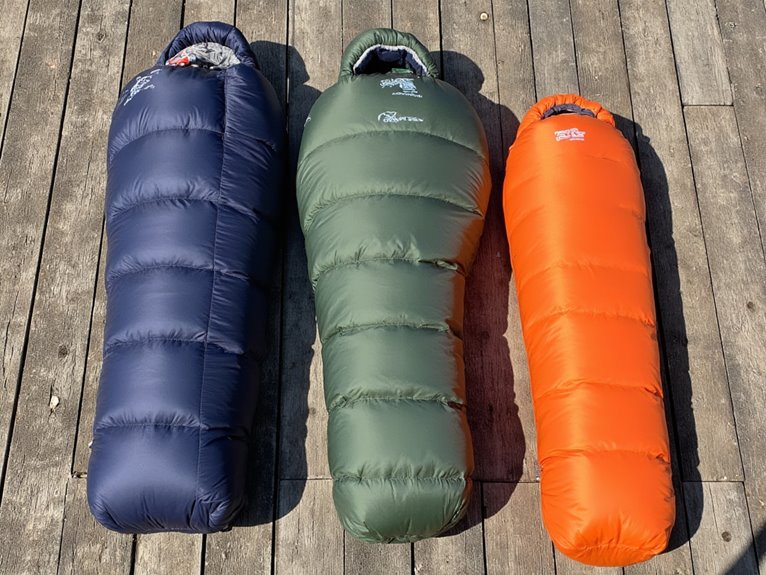
Understanding temperature ratings is essential for selecting a sleeping bag that’ll keep you warm throughout the night.
The EN and ISO rating systems provide standardized temperature thresholds—including Comfort, Lower Limit, and Extreme ratings—that indicate a bag’s thermal performance under controlled testing conditions. The Lower limit indicates comfort for men, while the Comfort limit is designed for women’s warmth needs.
Your seasonal camping plans directly influence which temperature rating you’ll need, from sub-zero winter bags rated below -20°C to lightweight summer options rated above 0°C. Women typically require bags rated 10-15 degrees warmer than standard ratings to maintain adequate comfort levels. Keep in mind that real-world comfort may differ from lab results due to individual factors like body type, clothing, and personal warmth preferences.
Remember that your sleeping bag works as part of an insulating system that includes your sleeping pad and any liners you use.
Understanding Temperature Ratings
Temperature ratings serve as your primary guide when selecting a sleeping bag, but they’re not as straightforward as you might expect.
These standardized measures use ISO 23537 testing protocols with heated manikins in climate-controlled environments. The process maintains constant temperature and humidity while allowing bags to reach full loft before testing begins.
Three distinct ratings define performance parameters. Comfort rating indicates temperatures where a “standard woman” remains comfortable in relaxed posture. Limit rating shows where an “average man” maintains thermal equilibrium without shivering. Extreme rating represents survival thresholds in emergency conditions. Women’s sleeping bags typically include 10-15 degrees Fahrenheit more insulation to accommodate physiological differences.
When conducting temperature rating comparison, consider that insulation performance varies between down and synthetic fills. Individual factors like metabolism and sleeping position considerably affect perceived warmth, making these ratings guidelines rather than absolute guarantees for your specific needs. However, the standard becomes less effective for extremely cold conditions below -15°C, where experienced advice proves more valuable than laboratory testing.
Seasonal Bag Selection
Beyond raw temperature numbers, seasonal ratings provide a practical framework that matches sleeping bags to specific camping periods and weather patterns.
Season 1 bags target summer use with minimal insulation above 35°F. Season 2 handles late spring and early autumn conditions. Season 3 covers autumn and winter without frost, while Season 4 manages cold winter nights with potential snow.
Your choice depends on sleeping bag materials and expected conditions. Summer bags prioritize lightweight, breathable fabrics. Winter options require heavier insulation types—down offers superior warmth-to-weight ratios in dry conditions, while synthetic fills perform better when wet. First-time buyers should select bags rated 15°F warmer than forecasted overnight temperatures to ensure adequate comfort.
Consider your local climate variations. A 3-season bag suffices for mild winters but fails in arctic conditions. Always verify forecast temperatures, as seasonal ratings don’t account for microclimate differences in your specific camping location. Temperature ratings include both comfort limits and extreme survival temperatures to help guide your selection.
Down Vs Synthetic Insulation: Pros and Cons
When you’re selecting insulation for your sleeping bag, the choice between down and synthetic materials will greatly impact your comfort, pack weight, and budget.
Down advantages include superior warmth-to-weight ratios and exceptional compressibility for backpacking. High-quality down retains loft for decades with proper care. However, down loses insulating power when wet and costs considerably more than synthetic options.
Synthetic insulation performs better in humid conditions, retaining warmth even when moist. Synthetic disadvantages include heavier weight for equivalent warmth levels and reduced longevity compared to down. However, synthetic materials dry faster, cost less, and require simpler maintenance requirements. Additionally, synthetic sleeping bags are hypoallergenic properties that make them ideal for those with allergies.
Choose down for dry, cold climates where weight matters most. Select synthetic for wet environments, budget-conscious purchases, or situations requiring minimal maintenance requirements. Down/synthetic blends offer a middle ground, providing balanced benefits by combining the water resistance of synthetic materials with the compressibility of down insulation. When considering down options, look for sleeping bags with 650 fill power or higher for optimal warmth-to-weight performance on backpacking trips.
Finding the Right Fit and Size

After selecting your insulation type, proper sizing becomes the determining factor between comfortable sleep and a restless night outdoors.
Measure your body dimensions accurately rather than guessing. Your shoulder width plus 10 inches determines ideal bag width, while height guides internal length selection. Regular bags accommodate 190-215cm users, with Long versions extending to 210-230cm.
Consider your fit preferences and sleeping habits when choosing bag style. Mummy bags offer snug thermal efficiency but restrict movement. Rectangular styles provide roominess for side sleepers at the cost of weight and warmth retention.
Your sleeping bag length should exceed height by 10-15cm for comfort without excess volume. Shoulder girth measurements guarantee proper torso fit, preventing cold spots while maintaining thermal efficiency through minimized dead air space. Users at size range extremes should consider sizing up for more space or sizing down for better heat retention. Pay special attention to footbox fit as a close-fitting foot area is essential for better warmth retention throughout the night.
Weight and Packability for Different Camping Styles
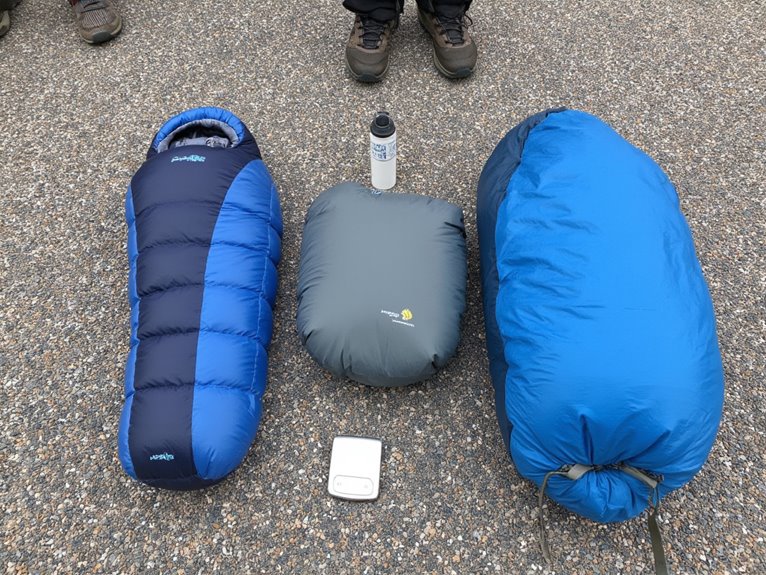
Your camping style directly determines how much weight and packability matter in your sleeping bag selection.
If you’re backpacking, every ounce counts since you’ll carry everything on your back for miles, making lightweight down bags with superior compression ratios your best choice.
Car campers can prioritize comfort over weight restrictions, allowing for heavier synthetic options that offer more space and durability without the penalty of manual transport. Down bags can cost three times more than synthetic alternatives, but the investment may be justified for serious backpackers. Modern ultralight sleeping bags can weigh as little as 1 pound while still providing adequate warmth for most conditions.
Backpacking Weight Priorities
Although all sleeping bags serve the same basic function, your camping style dramatically affects which weight and packability features matter most.
Ultralight techniques demand bags weighing 1-3 pounds, while standard backpacking accommodates 2-4 pound options. Weight distribution becomes critical when every ounce counts on long treks.
Your backpacking approach determines specific weight priorities:
- Ultralight Backpacking: Target sub-2-pound bags with high fill power down (800+) for maximum warmth-to-weight ratios.
- Standard Multi-Day Trips: Accept 2-4 pound range for enhanced durability and comfort features.
- Weather-Dependent Selection: Choose synthetic insulation in wet climates despite weight penalties.
Down insulation provides superior weight efficiency but loses effectiveness when wet.
Synthetic alternatives weigh more but maintain warmth in moisture. Sleek mummy bag shapes weigh less than roomier rectangular alternatives for equivalent insulation. Use warmth-to-weight comparisons to evaluate how different bags perform relative to their weight across various temperature ratings.
Compare compressed volumes directly—a 15-liter stuff sack difference greatly impacts pack organization and hiking comfort.
Car Camping Flexibility
Car camping transforms sleeping bag selection by eliminating the weight and packability constraints that dominate backpacking decisions. You can choose bags weighing 4-6 pounds or more without consequence.
This freedom enables superior car camping comfort through thicker insulation, plush linings, and spacious designs. Vehicle storage capacity allows bulkier materials and roomier footprints.
You’ll find sleeping bag features like integrated pillows, adjustable hoods, and zippered ventilation systems. These additions would be impractical for backpacking but enhance comfort markedly at established campsites.
Temperature ratings become more flexible too. Heavy-duty winter bags with 800+ fill power down work excellently for cold-weather car camping. Conversely, lightweight summer options remain viable when conditions permit.
The key advantage is choice without compromise on warmth or comfort features. Many car camping bags feature rectangular designs that provide extra room for movement and comfort compared to the restrictive mummy-style bags preferred by backpackers. Car camping also allows you to prioritize comfort ratings over weight considerations when selecting temperature ratings for your expected conditions.
Down Versus Synthetic
Once weight and packability become primary concerns, the choice between down and synthetic insulation fundamentally shapes your sleeping bag’s performance characteristics.
Down insulation advantages include superior warmth-to-weight ratios and exceptional compressibility, making down bags markedly lighter and more packable than synthetic alternatives. Higher fill-power down (700+) maximizes these benefits.
Synthetic insulation pros center on moisture resistance and maintenance simplicity. You’ll find synthetic bags retain warmth when wet and dry faster than down options. Modern synthetic fills utilize hollow fibres that trap more air than solid fibres for enhanced thermal efficiency and heat retention.
Key performance differences include:
- Weight: Down bags weigh 20-30% less than synthetic equivalents
- Pack size: Down compresses to 60-70% of synthetic bag volumes
- Wet performance: Synthetic maintains 80% insulation when damp versus 20% for untreated down
Down bags often feel warmer than synthetic bags with identical temperature ratings, providing better sleep quality in challenging conditions.
Consider your camping environment and weight priorities when selecting insulation type.
Essential Features and Design Elements
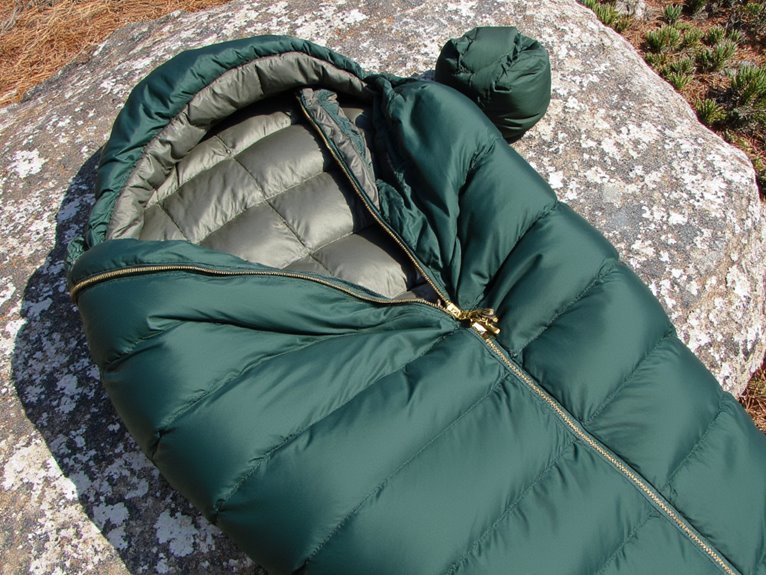
When selecting a sleeping bag, the shape fundamentally determines both thermal efficiency and comfort level. Mummy bags taper toward the feet, minimizing dead air space for maximum warmth.
Rectangular designs offer roominess but sacrifice heat retention. Semi-rectangular bags balance both factors effectively.
Zipper functionality directly impacts usability and thermal performance. Quality zippers prevent snagging while maintaining smooth operation in cold conditions.
A reliable zipper system ensures seamless access and prevents heat loss through secure sealing and consistent operation.
Draft collars around the neck area create essential heat traps, preventing warm air escape. Zipper draft tubes seal the entire zipper length against air leakage.
Additional features enhance performance considerably. Adjustable hoods with drawcords provide customizable warmth.
Stash pockets near the chest keep essentials accessible. Pillow pockets accommodate stuffed clothing for head support.
Pad loops secure sleeping pads, preventing dangerous shifting during sleep.
Matching Your Bag to Climate Conditions
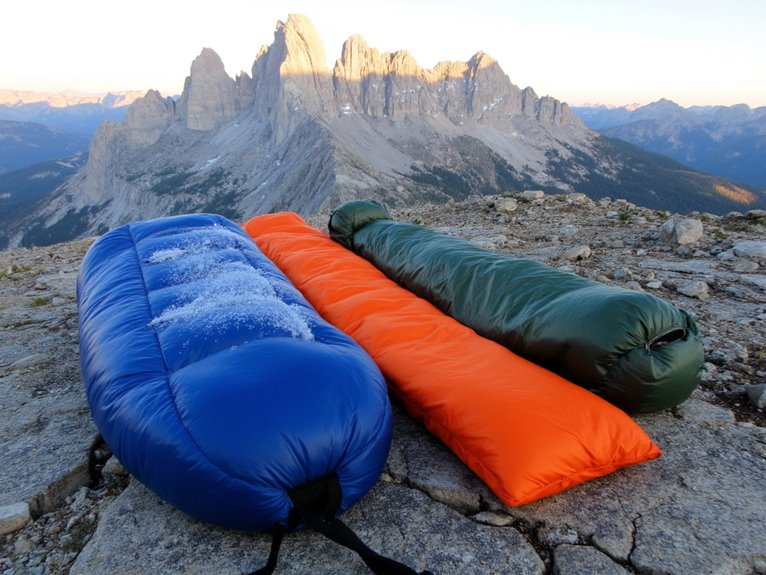
Temperature ratings serve as your primary guide for selecting a sleeping bag that’ll perform reliably in specific climate conditions. Understanding EN 13537 standards helps you make informed decisions based on Comfort, Lower Limit, and Extreme ratings.
Your temp consideration should account for expected nighttime lows plus a safety margin. Climate adaptability depends on matching insulation type and features to your environment:
- Warm climates (35°C/95°F+): Choose lightweight synthetic bags with ventilation features and breathable materials.
- Moderate conditions (0°C to -10°C): Select versatile 3-season bags with down insulation and adjustable features.
- Cold environments (below -10°C): Opt for high fill-power down bags with waterproof shells and enhanced heat retention.
Balance your bag’s rating against ground insulation and expected weather variations for best performance.
Budget Considerations and Value Factors
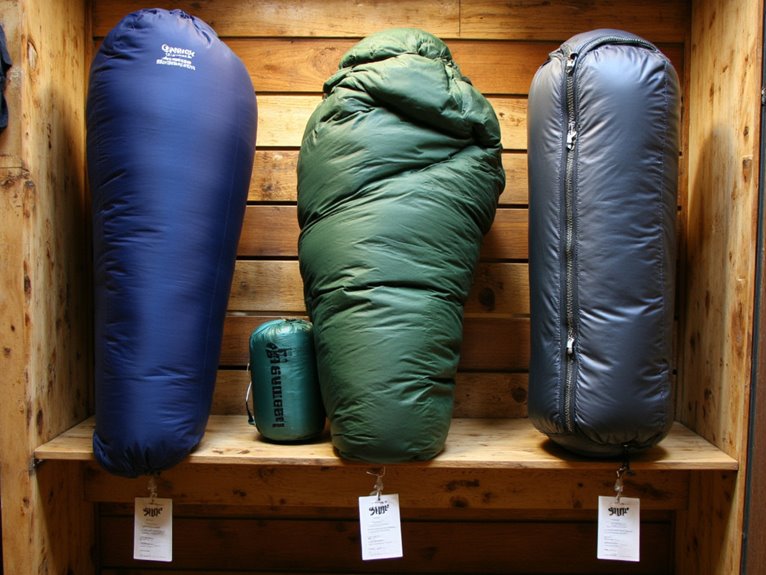
While premium sleeping bags deliver exceptional performance, your budget doesn’t need to break the bank for reliable warmth and comfort. Entry-level bags range from $50–$150, with many solid budget options under $100 from brands like Mountain Equipment, Alpkit, and Coleman.
Understanding cost trade offs helps you make informed decisions. Budget bags use synthetic insulation, which weighs more than down but tolerates moisture better. You’ll sacrifice advanced features like draft tubes and cinchable hoods. Weight typically ranges from 1.5–2.5 pounds versus under 2 pounds for ultralight models.
Budget sleeping bags trade weight and premium features for affordability, using synthetic fill that handles moisture better than down.
Mid-range bags around $150–$300 offer better shell materials and improved stitching. For casual campers and occasional users, budget bags provide excellent value.
REI Co-op Trailmade 20 and Coleman Kompact 30 consistently rank as top value picks.
Care and Maintenance for Longevity

A quality sleeping bag represents a significant investment, but proper care and maintenance can extend its lifespan from 5-7 years to well over a decade of reliable performance. Effective care routines begin with preventative measures like using bag liners and wearing clean clothes to minimize dirt accumulation.
Essential maintenance tips include:
- Washing frequency: Clean your bag at least annually, using warm water with mild soap on gentle cycles.
- Proper drying: Air dry for 24+ hours or use low-heat settings to preserve insulation integrity.
- Storage protocol: Store in breathable sacks in cool, dry locations—never in compression sacks long-term.
Avoid dry cleaning, which strips down’s natural oils. Regular spot cleaning handles minor stains effectively.
Always verify complete dryness before storage to prevent mold formation.
Frequently Asked Questions
Can I Use a Sleeping Bag Liner to Extend Temperature Ratings?
You can extend your sleeping bag’s temperature ratings using liners made from different insulation materials.
Fleece and thermal liners add the most warmth, increasing ratings by 8-25°F depending on conditions.
Synthetic insulation materials work best in humid environments, while silk provides lighter warmth for moderate conditions.
The actual temperature boost varies based on your sleeping bag’s existing insulation, environmental factors, and liner quality.
How Do I Prevent My Sleeping Bag From Sliding on the Tent Floor?
You’ll prevent sliding by addressing contact friction between sleeping bag materials and tent floor types.
Place non-slip mats or backpacking towels beneath your bag to increase grip on slippery surfaces. Anti-slip tape works on polyurethane-coated floors but may damage Dyneema composite materials.
Consider integrated sleeping systems that combine bag and pad into one unit, eliminating independent movement that causes sliding during sleep.
What’s the Difference Between Men’s and Women’s Specific Sleeping Bags?
Women’s sleeping bags feature shape differences designed for wider hips and narrower shoulders compared to men’s bags.
You’ll find women’s insulation is strategically increased in core areas and footboxes since women typically sleep colder than men.
Women’s bags are shorter in length, reducing unnecessary material while maintaining warmth through higher fill power down.
Temperature ratings reflect these physiological differences between genders.
Can Sleeping Bags Be Repaired if They Get Torn or Damaged?
You can repair torn sleeping bags using several effective repair techniques.
Small holes require Tenacious Tape patches cut larger than the tear. Clean the damaged area first, then apply adhesive to both surfaces. Press from center outward to prevent air bubbles.
For larger tears, use whip stitching with matching thread.
Carry patch kits containing adhesive patches, tape, and needles for field repairs.
How Long Do Sleeping Bags Typically Last With Regular Use?
Your sleeping bag’s lifespan depends on several durability factors.
Down bags last 10-15 years with regular weekend use, while synthetic bags typically last 3-5 years.
Heavy use reduces these timeframes considerably—down may lose warmth after 300 nights of constant use.
Key maintenance tips include storing uncompressed, cleaning properly without harsh chemicals, and controlling moisture exposure.
Higher-quality materials and proper care extend longevity substantially.
On a final note
You’ve now got the technical knowledge to select a sleeping bag that matches your specific needs. Consider your typical camping temperatures, preferred insulation type, and required packability. Don’t compromise on proper fit—it directly affects thermal efficiency. Balance your budget against essential features like quality zippers and draft collars. Remember that proper care extends your bag’s lifespan considerably. Choose wisely, and you’ll have reliable backcountry sleep protection for years.

